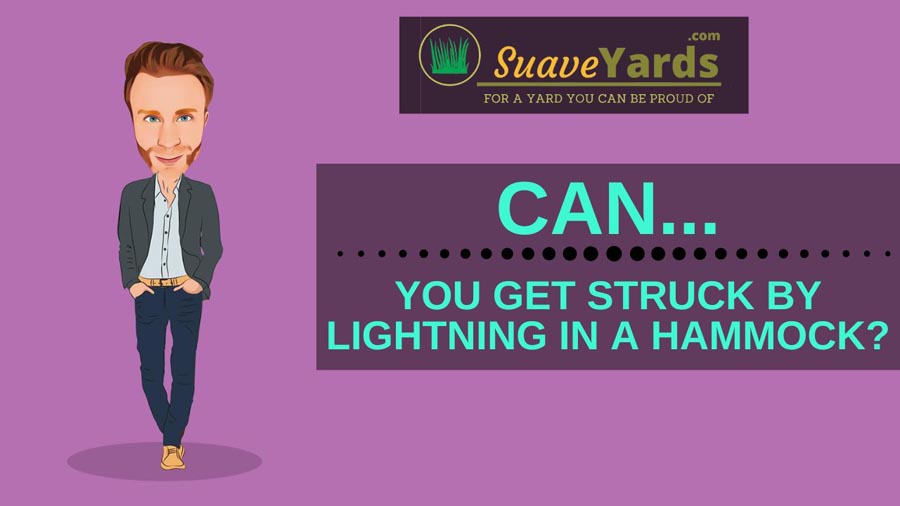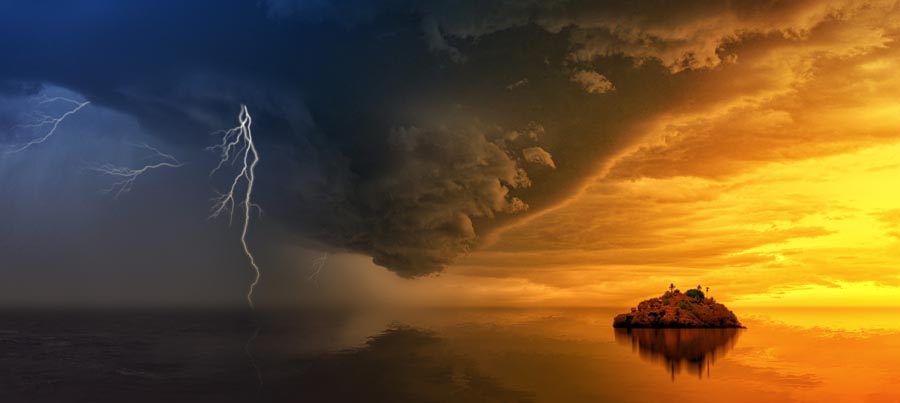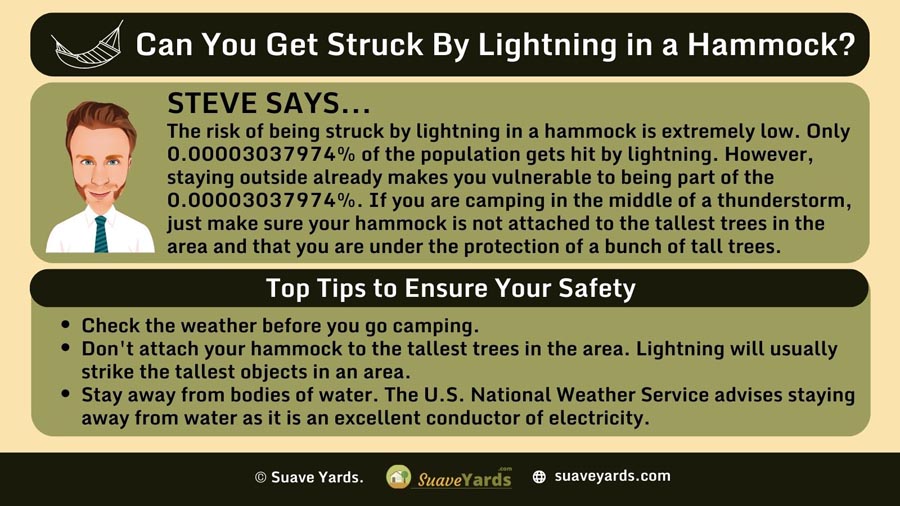
Every second, about 50 lightning events happen in the world. About 20% of these result in ground strikes that could hit people, albeit, rarely.
It is estimated that around 240,000 people get hit by lightning every year and 24,000 of them die from the incident.
A person can get hit by lightning whether they are indoors or outdoors, but being in an open area is more dangerous as one can be hit directly, which is fatal.
Does this mean camping in a hammock ups your chance of being struck by lightning?
Let’s discuss.
The risk of being struck by lightning in a hammock is extremely low. Only 0.00003037974% of the population gets hit by lightning. However, staying outside already makes you vulnerable to being part of the 0.00003037974%. If you are camping in the middle of a thunderstorm, just make sure your hammock is not attached to the tallest trees in the area and that you are under the protection of a bunch of tall trees.
Does Hammock Camping Make You Vulnerable to Lightning Strike?

Technically, it’s being outdoors that increases the chance of being struck by lightning, no matter how low the probability is.
There are five ways a person gets hit by lightning:
1. Direct Strike
A direct lightning hit is very rare but it’s also the most dangerous.
The person hit becomes part of the main lightning discharge channel.
When a direct strike happens, the current moves and part of it goes through the skin, and another moves through the cardiovascular or nervous systems.
The lightning’s heat results in burns, cardiac arrest, or electric shock.
2. Side Flash
It happens when lightning strikes a tall object near the victim.
The lightning’s current will jump from the tall object to the shorter victim, who will then suffer from electric shock.
It mostly happens when the person is just a foot or two away from the object struck by lightning.
3. Ground Current
When lightning hits something, the current travels outward on the ground surface.
Anyone nearby, standing on the ground where the current is traveling, can become collateral damage to the lightning strike.
People inside buildings may be vulnerable, too, as current can travel on some floors made of conductive materials.
4. Conduction
Most indoor victims of lightning strikes are due to conduction.
People who come in contact with metal wires, plumbing, and metallic surfaces that have extensions outside can be indirectly struck by lightning.
The lightning will possibly hit any of these materials outside and the current travels inside and into the person linked to it.
5. Positive Streamers

You know how lightning isn’t drawn as a straight line? That’s because it doesn’t travel in a straight line.
Lightning flashes happen because of the negatively charged ladders called stepped ladders.
They respond to the strong electric field, which makes the move downward fast.
When human bodies are subjected to a strong electric field, such as a storm cloud, it produces positive streamers that attract stepped ladders.
When the positive streamer and stepped ladder meet, a lightning strike happens and the air around becomes extremely hot. A person may experience burns.
This is not a cause of lightning strike death among people as there are many more positive streamers on an electric field.
So, How Can You Get Struck By Lightning in a Hammock?
Obviously, anybody can be directly struck by lightning, but it’s not very common.
But if you are in a hammock, you are not in a wide-open area since hammocks need to be tied to trees or poles.
It reduces your risk of a direct lightning strike, but not others.
For one, it is conducive for side flash.
Most of the people struck by lightning through side flash are because they were trying to take shelter from trees during a storm.
However, lightning strikes the one nearest its path.
That means that the tallest tree will most likely be hit by lightning.
When you are in a hammock, you are not in danger of ground current or conduction.
Since you are not on the ground, then there is no danger for electric current to strike you as it passes through the trees’ roots and spreads elsewhere.
Hammocks don’t have conductive parts that make them vulnerable to lightning strikes.
Lastly, when camping or staying in a hammock, you are mostly surrounded by trees, which makes it less likely for the lightning to respond to your positive streamers.
Tips to Avoid Getting Struck By Lightning in a Hammock
Just because statistics of lightning strikes are not alarming, it doesn’t mean that you can be chill about it.
Be more prudent.
Here are some tips to prevent getting struck by lightning while in a hammock:
Check the Weather Before Camping
If the weather forecast isn’t good, then don’t force it.
Don’t be adventurous and brave rainstorms because they are dangerous:
- The cold may result in hypothermia.
- You may encounter floods or flash floods.
- You could be struck by lightning.
But if you were caught in a storm in the middle of camping, then you should try to be as safe as you can.
Don’t Attach Your Hammock to the Tallest Trees in the Area
You already know lightning’s propensity to choose the tallest objects in the area to hit, so find shelter in shorter trees.
The tall trees will not only become a lightning target, but they will also shelter you from the downpour.
Some camping enthusiasts have the following pieces of advice in a hammocks forum:
“I think it depends on the environment. If you hang on the only two trees on top of a hill – go away! It’s likely the lightning will hit one of the trees and will harm you. If you are hanging in the middle of the woods and your trees aren’t the biggest – stay in your hammock and enjoy the spectacle!”
“I think you would be safer if the trees you chose were lower down than toward the crest of the hill. Shorter trees that are not standing out in the open too much likely have less chance of being struck. When I worked briefly for the local Forestry Commission, the consensus was that lightning prefers lone trees and also dead trees.
“That said, I had a neighbor once that lost 14 dairy cows one night that had huddled under the lone oak in the field. They all died. I don’t know if being off the ground in the hammock would save someone from all that electrical energy or not but I would try not to have metal on my person and would definitely curl up into a fetal position and pray for the best.”
Stay Away from Bodies of Water

Some campers prefer being near the river because it’s practical for washing clothes and utensils.
However, it’s also the mosquitoes’ favorite place and is prone to lightning accidents.
As the U.S. National Weather Service said:
“Stay away from water, wet items, such as ropes, and metal objects, such as fences and poles. Water and metal do not attract lightning but they are excellent conductors of electricity. The current from a lightning flash will easily travel for long distances.”
Is a Tent Better Than a Hammock During a Thunderstorm?
There is no definite answer to this.
No statistics prove that one is better than the other in terms of protection against lightning.
On the one hand, the tent provides better coverage for the rain.
On the other, it has metallic poles that may not attract lightning but will conduct it.
Remember, people indoors can experience electric shock when they are holding metals that are linked to outside metals struck by lightning.
But hammocks are not safe either.
Just make sure you are not hammocking at the highest trees and there may be some semblance of safety.
And always opt for a cluster of trees, and choose the shortest ones, to have more protection.
As one Redditor aptly puts it:
“Hang in a patch of trees from the lowest (height) pair you can find. Then, put your faith in statistics.”
The stat is that only 0.00003037974% of people are struck by lightning every year.
What to Do When Lightning Strikes a Person?
The obvious thing to do is to call emergency services.
However, if you are hammocking, chances are that help will not be quick.
Here are some things you could do:
Move the Victim to a Safer Place
The first thing to do is move the person to a safer place, inside a tent to prevent them from being too wet from the rain.
But the tent has to be covered by trees too so that it is not the tallest object in an open area.
A cave would be ideal if there is one in the area.
It is safe to move the person as they won’t be charged.
They may suffer from cardiac arrest or burns, so you can safely move them without fear of contact with broken bones.
But if they do have burns on their bodies, make sure you don’t touch them when you move them.
Lay Them on a Sleeping Bag
It is important to have a protective layer between the ground and the person to protect them from hypothermia.
And since we are on that issue, cover them with a blanket as well.
But do that when you know their heart is still beating and they are breathing.
Do CPR
Since the person struck by lightning may have suffered from cardiac arrest, conduct cardiopulmonary resuscitation (CPR).
Do Mouth-to-Mouth Resuscitation
If the person is not breathing, then you should do mouth-to-mouth to revive them.
Final Thoughts

Hammocking is great, but you should not be too adventurous that you would brave thunderstorms and risk being struck by lightning.
The good news is, the risk of being struck by lightning is pretty low.
However, it’s also random.
Not one person is more vulnerable than the next.
It’s the situation that makes people more prone to be hit by lightning.
You don’t want to be part of the statistics, do you?
